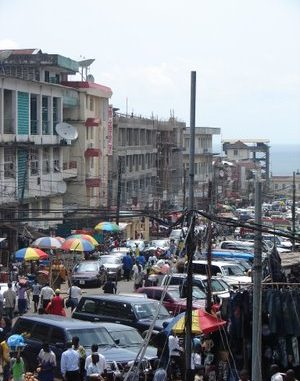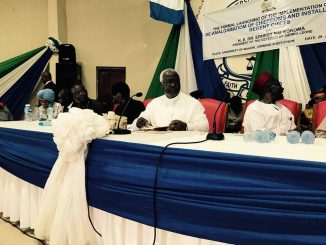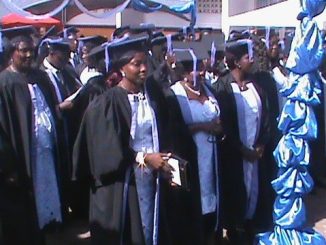
Titus Boye-Thompson, Strategic Media & Development Communications Unit :
The contention about moving traders from Sani Abacha Street is slowly being molded into a kindred struggle to expunge the ghosts of Freetown’s past. In such an exercise, it becomes easily clear that this city, once referred to as the Athens of West Africa is taking some time to get to grips with the harsh outer realities of its forced growth without proper planning, resource and manpower utilization to augment sustained and planned development. The admixture of its peoples has always made Freetown a metropolitan city. Welcoming to visitors as well as indigenes of Sierra Leone, Freetown made its name on the backs of merchants, sea, navy, land and itinerant who passed through these shores to seek their fortunes in the vast riches of this Country, prospecting for gold and diamonds but needing these natural harbor to land their supply ships and materials. In the milieu of Portuguese explorers, English slave traders, Syrian corrals and Lebanese grafter, this city has also encouraged the Temne batta, Loko market gardeners from the mountain villages, Sherbro boatmen ferrying cassava derivatives such as gari and foofoo as well as Mende produce farmers plying their wares of coffee and cocoa, palm oil and piassava. The idea therefore that within this mix of cultures, peoples and traditions, there is a hint of tribal upperclass is evasive and obtuse.
Freetown has always been home to the Temnes, a descendant of the people of the ancient kingdom of Koya. Their attitude to befriend and welcome foreigners even to their own detriment saw them selling land on such venerable terms as cannot be compared to any other part of the World. It is plausible that they were not even aware of the extent of land they sold to the British, but were so mindful of the Cotton Tree that is located in what is now the centre of Freetown that their only concern was that all land proximate to the Cotton Tree was available on the sublime condition that the Cotton Tree should never be cut down as that tree marks the limitation of their yielding of land to these people from abroad, these “Orpotoes.” Hence the central markings of Creoledom is any place visible from the Cotton Tree and vice versa. This demarcation started at first as that portion and parcel of land between the Cotton Tree and Fort Thornton in the North, the sea in the south Fire Burn in the east and Jokee Bridge in the west. It was subsequently extended as far as from Up Gun in the east and then onwards to St John in the west. The Temne Kings of the day were apathetic as to wherever else the Creoles chose to settle because as far as they were concerned, any land not visible from the Cotton Tree had nothing to do with them, such land was inevitably wasteland. Not until the Creoles breached the Peninsular in the White Man’s quest to explore what lay behind these gargantuan mountains and in that process circumnavigated what is now termed the Freetown Peninsular and its crop of villages, did the Temne Kingdoms of King Tom and King Naimbana became re-acquainted to the existence of the greater Koya Kingdom extending upwards from Waterloo to Mile 38.
The historical sketch is indicative of the wider expansion of a colony people whose settlement became rapidly outgrown with the influx of freed slaves, re-captives and other peoples from the West Coat of Africa and its shores. Thus Freetown’s character quickly became that of a melting pot and the emergence of krio as a common language became exigent on the personification of these varied peoples under a demanding master race, the British colonialists, determined to retain control of these shores and the riches that lay beyond it. The overplay of this metropolitan nature of Freetown’s founding are derived from the distinction and power play that was to later emerge. The indigene Temnes were determined not to be influenced nor affected by the ways of their visitors, so therefore for a long while stayed aloof from them. The incoming tribes on the other hand quickly recognized the benefit of cultivating a common culture and therefore brought together snitches of their original cultures and language, embedding them into the perception of language derived from their interpretation of the white man’s language to effuse a working medium of communication in patois that is distinctly Creole in nature. The term Creole is therefore not limited to the people of whom are recognized as an admixture of cultures but is recognizably a determination of the origin of these people, their dexterity in assimilating in this strange yet friendly environment. It became exchangeable with a description of a way of life much more than as a description of a tribe or people.
The battle therefore has always raged between the Temne and the Creoles of Freetown but that battle almost always degenerates to a brawl. It has never been a serious battle. The Creoles moved swiftly on to cultivate the Temne and as that interaction established itself, they scolded them to send their children to school and give them an education. The Temne who is now articulate and well educated therefore has some engagement with a Creole somewhere and it is that mutuality in their existence that has made these two more closely bonded than any other two tribes in Sierra Leone
There is also the consideration that wherever the Creoles settled, they built their churches and established their denominations. The Temnes were the first indigenous tribe to be so cultivated into Christianity to the extent that they also started to do the same. They built their own churches and even ventured further to establish their own denomination alongside the Lokkos and Limbas, the Wesleyan Methodist Church. To the extent that these peoples have so engaged in cross cultural and traditional engagements, bonded by religion, ity became quickly evident that their continued sustenance in this city has been based on the recognition of their mutuality rather than an agnostic adherence to tribal differences or inclinations. Tribalism is therefore the very last excuse for any conflagration in Freetown.
The extension of this doctrine is necessarily being superintended by those who are now seeking to drag a wedge between the wholesome people of Freetown. The Temnes and the Creoles easily support the All People’s Congress (APC) party for the very same reasons as has been explained above. They both see in that party, a coalition of ideas that succumbs to their mutuality. They do not see the hegemonistic display of tribal supremacy paramount in other parties or political conceptions but in the APC is a welcome space for gratification and a potential for growth and recognition of effort. There is a seeming meritocracy within the APC that is not easily discerned within its main rival, the Sierra Leone People’ Party, (SLPP). In that party, the Mende hegemony is rampant and entrenched, anecdotally evidenced by the very nature and characteristic of the Mende as he interlaces his conversations in English with sometimes intemperate Mende phrases and idioms.
The Creoles in Freetown therefore have more in common with the Temnes and for that matter, are trusted by the Temnes to run and manage this City. It is evocative of the history of the Freetown Municipality that the succeeding years have seen more Creole Mayors and Chair persons of Council than any other tribe, even though the overwhelming majority of Councilors are constituted by the other prominent tribes of Temne, Lokko and Limba. Freetown is a very singular city. Its establishment and growth has always been based on the acceptability of our differing cultures and idiosyncrasies. This is not a city that thrives on tribalism or on the divisive nature of our cultural backgrounds. Freetown is a haven for the struggling and dispossessed. However, the ambience of this city should be maintained as a place fit for civilized people to cohabit. The need to decongest Freetown is not a tribal determinant of occupancy but a n environmental necessity, back by the requirements of good public health and sanitation. The President’s vision to tackle waste management, indiscipline and decongestion for this city far outstretched by inadequate resources and land use is a simple call for law and order and for a recognition that citizens of this city should be proud of their historical ties to this place and hence keep it habitable and environmentally stable. His was never a call for divisiveness nor destruction of our melting pot atmosphere of good camaraderie





Leave a Reply